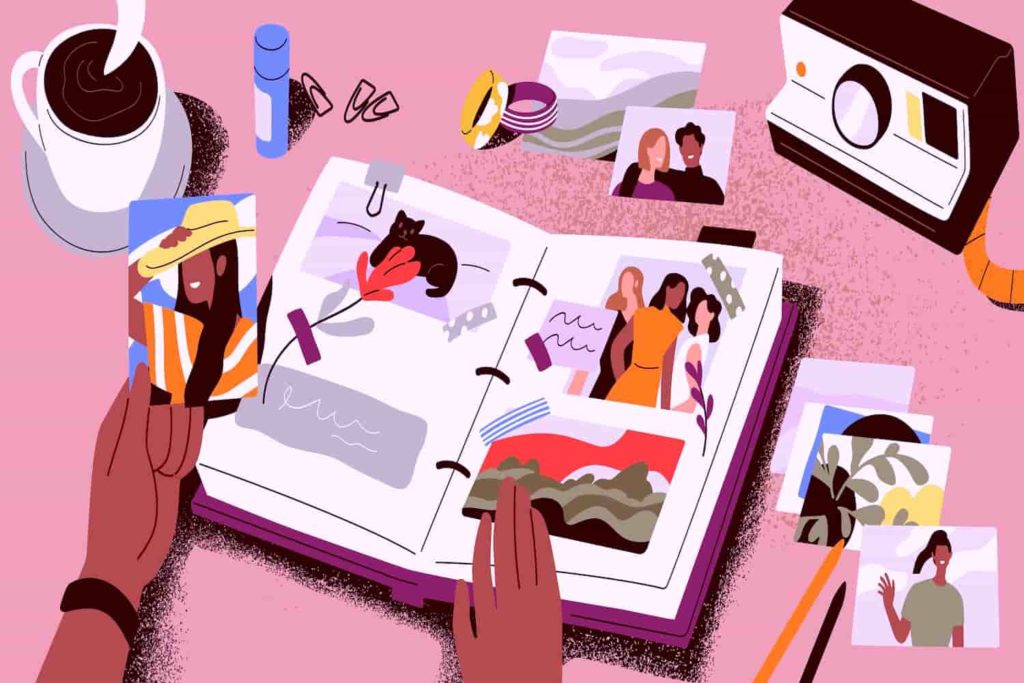
Glue It Down! (Getting Past the Plan)
I don’t often fly by the seat of my pants; I plan everything out in advance. My nineth-grade English teacher would be so proud of the beautiful outlines I construct for my writing. My problem is moving from outline to essay, from plan to action. And let’s face it, no one gets credit for a fabulous essay outlined but never written, or wins an award for a film planned but never made, or is warmed by a quilt patterned but never sewn. In this essay I explore the issues that people often have moving from creative plans to creative action (at least that’s what my outline says I’m going to do).
The Vision Board
This topic has become urgent for me because I am currently a student enrolled in a class, which is a change from my usual role as the one teaching. One of the assignments for the class I’m taking is to make a vision board. That’s an exciting but fearsome task: exciting because I love the concept of vision boards, and fearsome because I have a long history of unfinished ones. I love brainstorming the vision, cutting out inspiring pictures and words, and even planning out the different sections of my creation. The obstacle arises at the moment of pasting the images to the tagboard. I freeze. Are you beginning to see a pattern?
What the Cause is Not
This pattern of difficulty moving from creative plan to creative action is one I have witnessed in myself, my students, my family, and friends over the course of many years. Not everyone has the issue, but it is widespread. The underlying causes are varied, so if you face this obstacle, I invite you to explore what may be impeding your own creative process. But first I want to clarify a common misconception

To be clear, difficulties moving from plan to action do not spring from laziness. People who don’t have issues moving on from the planning stage often blame such hesitations on sloth. But I have rarely met a lazy person who put time and effort into a beautiful roadmap for a journey that they never took. Rather, these types of people are often productive and accomplished in many areas of life but also tend to be thoughtful and sensitive, sometimes to an extreme. People who aren’t thoughtful don’t tend to consider the repercussions of their plans, and therefor often have less difficulty bulldozing forward into action, no matter the consequences.
Extremely thoughtful and reflective people are not lazy but rather have the burden of taking into consideration all the possible repercussions of their creations. While considering consequences is a good thing, if it keeps you from putting your creativity into the world, it may be time to manage those considerations.
Variations on a Scheme
You are a thoughtful person, and so you have considered the consequences of your creative plans. You have determined that your abstract painting exploring the inner life of your dog will in no way cause physical or emotional harm to anyone. But you still have trouble moving from creative plan to creative action. What’s going on?

Plans that continue to be impeded by overthinking often have the root cause of fear. This fear comes in a variety of flavors: fear of criticism from the outside world, fear of criticism from the self (also known as perfectionism), fear of failure, fear of success, to name just a few.
The bad news is that if you put your creativity out into the world, all your fears will come true: others will criticize you; you will criticize yourself; you will have both failures and successes. The good news is that these things could happen anyway (maybe that’s not good news, but it is a reality). If you don’t put yourself out into the world creatively, you’ll still have the worries but without the satisfaction of the well-written essay, the award-winning film, or the beautifully sewn quilt.
I don’t mean to be flippant, because for sensitive folks, the fears about creative action are real; I know because I have them, too. Working on my anxieties has gotten easier, and I wish I had started sooner. I can’t speak to solutions for everyone’s fears around moving from plans to action, but I can describe a few practices that have worked for me.
Three Techniques
Many methods are available for moving beyond creative anxieties, but there are three that have been especially helpful for me. When I find myself stuck in the planning stages of creativity, I take one of these three actions: I do something small; I do something badly; or I do something without a plan.
One of my dreams for the last several years has been to write a book about creativity. This website and blog are, in part, a technique for making progress in that area. In the beginning, I kept on getting stuck in both the outline stage and the fear of the larger project of the book. “If that’s too big, do something smaller,” I said to myself. Could I write a short blog post on creativity? Yes, I could do that. And then I did. And here you are reading one. Writing the posts in this blog has gotten me moving toward the larger goal of the book.

Another technique I use comes out of a piece I heard on NPR many years ago. It was about a group of musicologists who purposefully created “bad music” that would supposedly be unlikable by the public. They did surveys about people’s favorite and least favorite types of voices, instrumentation, styles of music, and lyrical themes. They then produced music that would supposedly be loved by the masses and, to the other extreme, music that everyone would hate. The “popular music” was insipid and terrible. The music that was supposed to be hated, in reality, was hilarious, creative, and enjoyable. I learned the lesson that purposefully doing something badly is often a gateway into creativity. Sometimes the purposefully bad essays I have written have ended up being my favorites.
When my plan is getting in the way of my action, another helpful technique is to try something without any roadmap whatsoever. I take a small chunk of the project I’m working on, give myself a time limit, and then just work. The important thing is not to stop the movement for reflection or planning. If I’m drawing, that might mean not putting my pencil down for a 15-minute period. If I’m writing, it might mean that my pen doesn’t stop moving or leave the page during the short session. Working for a short time without a plan is sometimes exactly what I need to move my larger project beyond the blueprint.
These are just a few techniques that I have found helpful when stuck in my planning. Maybe one of them will work for you.
Getting It Done
Well, I managed to do it: I wrote this essay! It didn’t turn out exactly like my outline, but then again it rarely does. I used two of the techniques described above in the process: the “do something small” technique helped me begin the essay by writing the paragraph about the vision board; the “do something badly” technique helped write the section on fears (and in the end, I don’t think that section turned out so bad).

Despite this minor triumph, I still need to get to that vision board assignment. I think the fear is that if I glue the images and words down, the vision will come true. But isn’t that the point? I guess I’m still a little afraid of success. How about I make you a deal: if you’ll start acting on one of your creative plans, I’ll complete a section of my vision board. Let’s both (metaphorically or literally) glue it down!